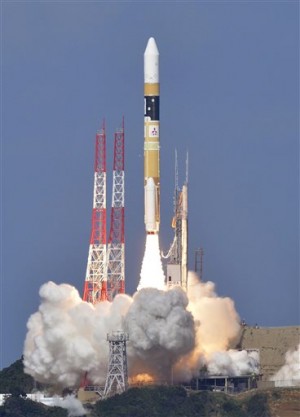
An H2-A rocket carrying a weather satellite lifts off from a launching pad at Tanagashima Space Center in Tanegashima, southern Japan, Tuesday, Oct. 7, 2014. AP
TOKYO — Japan put a new weather satellite into space Tuesday in the hope it can improve the forecasting of typhoons and detect volcanic gas plumes.
The successful launch comes the day after a typhoon strafed Japan and just over a week after a volcano killed more than 60 people when it erupted without warning.
The Japanese-made H-2A rocket carrying the Himawari-8 weather satellite blasted into a blue sky at the Tanegashima Space Center in southern Kagoshima prefecture at 2:16 pm (0516 GMT).
The 17 billion yen ($155 million) satellite separated successfully from the rocket and entered its designated orbit, sparking applause at the space centre, a Japan Aerospace Exploration Agency (JAXA) spokeswoman told AFP.
Japan’s Meteorological Agency will use the satellite, alongside the Himawari-9, which is to be launched in 2016, for forecasting and to replace its ageing Himawari-6 and -7.
The new satellite “can obtain a satellite image of a typhoon once every 2.5 minutes, against the current pace of once every 30 minutes,” an official of the weather agency told AFP.
“Together with improvement in computer-aided analysis, we hope our forecasts of a typhoon’s future course will be more accurate,” he said.
“As satellite images will become multi-color from the current black and white, it will be easier to observe volcanic gas” which will be helpful for early warnings of a volcanic eruption, he added.
RELATED STORIES
Rescuers rush to save people as Japan volcano erupts
Strong typhoon Phanfone makes landfall in central Japan